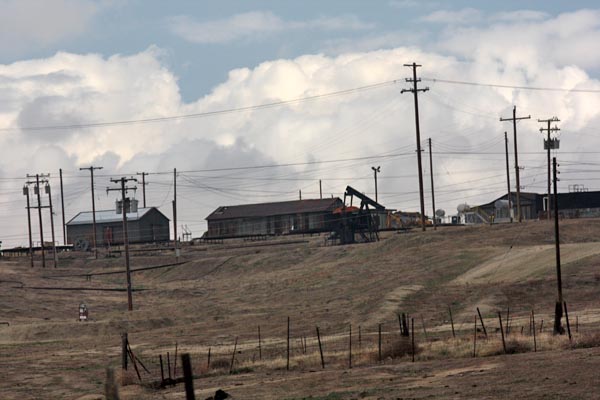 The Wheeler Ridge Maricopa Water Storage District held its board of directors meeting on Wednesday, May 13, 2020 by teleconference. The public portion of the meeting was scheduled to begin at 9:00am. I called in a little early and when folks started talking it was an echo chamber but someone got it fixed pretty quick; still some echo and it sounded like some one’s dog was hungry. WRMWSD Chairman Dennis Atkinson called things to order shortly after 9:00 and dispensed with the flag salute.
The Wheeler Ridge Maricopa Water Storage District held its board of directors meeting on Wednesday, May 13, 2020 by teleconference. The public portion of the meeting was scheduled to begin at 9:00am. I called in a little early and when folks started talking it was an echo chamber but someone got it fixed pretty quick; still some echo and it sounded like some one’s dog was hungry. WRMWSD Chairman Dennis Atkinson called things to order shortly after 9:00 and dispensed with the flag salute.
Attorney Steve Torigiani, it sounded like him anyway, he had nothing to say about the closed session that had just taken place. He did report on the recent TRO on the biops and said it is worrisome the federal judge in Fresno may have found a reason to believe there could be prevailing concerns in the request.
The minutes were approved. The financial reports were given by Director Jeffrey Mettler. It’s been a while since I attended a Wheeler Ridge meeting, a few years actually. That’s some hands on directing. Financials reports are usually given by staff. The agenda lists the item under the name Mettler. That’s why I was led to believe Mettler gave the report. It might have been Director Colby Fry. Someone asked General Manager Sheridan Nicholas what “home expenses” were. Nicholas said it’s a $30 a month allowance to help reimburse employee’s work related expenses incurred while working at home. Sounds good. The accounts payable was approved. WRM is the largest member unit of the Committee for Delta Reliability group and there were questions about how much was being spent. All the financial reports were accepted and approved.
The controller’s report was next on the agenda and I’m guessing the name of the presenter was Jim Smith from folks referring to him by his first name and the last name listed on the agenda. Took a while to get the system to unmute the poor guy. He started with delinquent reports saying Blue River owes $22,000 plus penalties. Blue River asked to hang on and they’ll get it taken care of and to please wave penalties due to problems with international customers dealing with coronavirus. Atkinson said the market with India and Spain are having real problems. He asked if anyone with overseas issues due to COVID-19 will become a domino effect of late payments. Director Jon Reiter said he shares that concern but the board was willing to consider waving penalties, not payments, until the virus issue fades. Torigiani said there is no executive order from Governor Gavin Newsom mandating the waiver of fees, although there is a prohibition to shutting off water and it isn’t clear if that applies to ag water suppliers. One director said it’s not just almonds, there are many growers who have been having trouble with the virus and have made payments. The idea was floated to allow them to accrue interest but putting off the payment of penalties until the last payment to give them a chance to catch up. But if they don’t make the payments their water will be cut off. The board approved this strategy. Staff reported the adjusted budget for the virus actions has been in line with estimates with a larger than planned savings on gasoline. Amen.
Each year in June the district passes a resolution to fix charges to the amount to pay for the benefits created by Wheeler Ridge and it will be published in the Bakersfield  Californian announcing it will be in effect in June. The board authorized the resolution after a long pause. The mysteries of teleconference. Everyone may have went to get coffee all at once. Staff reported in an echo-y disembodied voice the draft audit will be ready by next week and will be ready to review at next month’s meeting.
Californian announcing it will be in effect in June. The board authorized the resolution after a long pause. The mysteries of teleconference. Everyone may have went to get coffee all at once. Staff reported in an echo-y disembodied voice the draft audit will be ready by next week and will be ready to review at next month’s meeting.
Atkinson asked what the next item was and it was the President’s report of which he had none.
Nicholas gave his report and said staff asked him to inform the board of the district’s infrastructure. It was designed in the 1960s for specific flow rates and things have changed over the years. The system in places is running to capacity and there are not enough buffers to adjust to the changes in crop and husbandry. There will need to be some consideration of the concerns regarding future contacts. Speaking of the State Water Project allocations are not increasing from I believe 15 percent. There are questions going to the state as to why in almost identical years in the past there was a 35 percent allocation. Nicholas said the pump-in to the California Aqueduct issue has been resolved.
Nicholas invited WRM Resource Manager Wendy Jones to give her report but I’m pretty sure she didn’t mean to give chime tones reminiscent of those featured in the movie Close Encounters of the Third Kind. So Nicholas gave the report saying there is a plan to utilize more water banking supplies. He expects to get enough water from the water banks if district pumps do not fill the job.
Next Nicholas reported on water rates saying the water supply allocation of 15 percent SWP will cause usage of other supplies. But this deliverable amount will be less than the contracts state for per acre supplies. There will be 118,000 a/f available this year. Jones was able to get unmuted but there was a so much echo Nicholas continued. He said the O&M rate has been increased from $30 to $40 due to more pumping and conveyance with district facilities. He recited several different components of the rate costs like administration fees and other such. There are several different types of supplies and cost inputs but if I understood the cost was set at $538 per a/f. There was a long conversation  of how rates are calculated for various types of water; i.e. SWP, water bank, north of Delta purchases, etc. It was asked how much to get water from the Kern Water Bank to WRM turnouts on the Aqueduct. Nicholas said without a spreadsheet in front of he guessed costs broke down by acre foot to $120 for pumping, $8-$10 conveyance charges, $20 capital cost and replacement costs of $100 to put new supplies in place at the bank. A grower in WRM can sell his water back to the district. Atkinson said to come to a question cause his phone is running out of juice. The board approved.
of how rates are calculated for various types of water; i.e. SWP, water bank, north of Delta purchases, etc. It was asked how much to get water from the Kern Water Bank to WRM turnouts on the Aqueduct. Nicholas said without a spreadsheet in front of he guessed costs broke down by acre foot to $120 for pumping, $8-$10 conveyance charges, $20 capital cost and replacement costs of $100 to put new supplies in place at the bank. A grower in WRM can sell his water back to the district. Atkinson said to come to a question cause his phone is running out of juice. The board approved.
I believe it was Jim Smith who returned to the speakership to talk about fixed obligations. Water buyers in WRM have an eight installment payment option and how these payments are constructed can make a big difference in even payments or spikey balloon payments. Staff recommended a “smoothing” method to help prevent these big payments. The board approved.
Nicholas said miscellaneous water rates are approved each year and this year it’s $1,500 per a/f. The drier the year the more expensive this water becomes. The board approved.
Next former GM Rob Kunde spoke about the Delta Conveyance Project, the tunnels, or tunnel. Once again there were problems hearing the speaker. Kunde was also going to update the board on the Incidental Take Permit and the coordinated operations of the Delta between the feds and state.
Nicholas skipped ahead to meeting reports. He said the Kern Water Bank reviewed its audit and will be voted on next meeting. The Kern Groundwater Authority doesn’t have much happening. The audit and a grant deal were discussed at the last remote meeting. There are discussions with KGA and DWR about subsidence on the Aqueduct. There are still some boundary issues and what to do with scattered white lands. Part of WRM sits in the White Wolf GSA but the June meeting was cancelled. The Kern River Watershed Coalition, part of IRWMP, has swapped law firms. The South Valley Water Resources received an update by Scott Hamilton on the San Joaquin Valley Water Blueprint.
Kunde was able to join and he had about a clear a connection as anyone all day. He started on the tunnel project saying DWR is expecting CEQA in March of 2022 and no contract involving the Delta Conveyance Project can be entered into until CEQA is completed. He gave an intense and thorough written presentation taking into account all manner of consideration such as what happens to Article 21 Water if the tunnels produce more of that color of water. You can find that online in the board packet. Read it and you’ll know more about this topic than you thought you might ever want to. It still isn’t certain which member units will participate or not but Kunde said this process is no longer a “cram down”. Participation can be opt in or opt out. The Kern County Water Agency and 20 others throughout the state prepared an Agreement in Principle, AIP to allocate participation costs between participants. 
Kunde said there could be more state water in San Luis Reservoir and greater danger of spills of carryover. The Kern County Water Agency is speaking with Metropolitan Water District about sharing costs. Kunde acknowledged getting a grasp of the amount and complexities of this matter might benefit from “talking points” type outline to present a higher elevation view of the subject. There was a schedule that showed if the schedule is adhered to the tunnels could be moving water by the 2030s. Where is the money coming from? That depends on what it will be spent on; construction, permitting? Will gap funding be instituted? Kunde said this issue isn’t really being addressed but it won’t go away.
Next Kunde spoke about the State Water Project and the Incidental Intake Permit. He had another presentation but I couldn’t find it. He said there have been a number of lawsuits against the state from Met Water and many, many others over the ITP. There are now two plans; the federal Biops and the state ITP managing exports. The presentation included a Power Point slide deck. I couldn’t see it but from what Kunde was saying it is as good an explanation as I have heard. It even includes the X2 line. What it boiled down to as I gathered it the biops use fish presence and location and are new and improved allowing much more flexibility to pump. The ITP is based on data decades old and is set up to follow the calendar. Crazy, whether the fish are in danger or safe it doesn’t matter under the ITP, it’s based on the calendar developed from when the fish should be there. The Department of Fish & Wildlife had substantial input on the federal biops. But CDFW is choosing de facto implementation of SB1 based on outdated science. Shameless. It has been proven time and again throwing more water through the Delta based on the calendar has not improved the fish population.
There were many other pertinent nuggets of information in Kunde’s slide show, but I have to be straight to you, I couldn’t follow it without the visuals and have requested a copy. I hope to be able to share this with you because it lays out how the biops can actually help fish and water users and the ITP hurts the environment and the economy. I’ve long wondered if much of the through Delta flows are meant to dilute wastewater discharge in the Bay Area. What would happen if the amount of water from the Delta sent out to sea was reduced? Would the communities and industries on the Bay have to upgrade their treatment facilities to meet clean water standards? What would that cost?
I hope to get a copy of Kunde’s presentation to share with you. It was excellent.
Under unfinished business there were a couple of board members who needed to turn in their 700 forms. Under public comment I was joined in praise of Kunde’s ITP report. Good to know. Nicholas apologized for the dodgy audio situation and I’ll bet you money he’ll get it straightened out by next meeting. In my opinion one of the unreported effects of the virus forcing remote meetings is this; most district general managers are engineers. Engineers love to play with things and fix them. I could be wrong but I think many of the men and women in Nicholas position have gained some satisfaction from conquering audio visual meetings. And that was that.
DISCLAIMER OF RESPONSIBILITY; Waterwrights strives to provide his clients with the most complete, up-to-date, and accurate information available. Nevertheless, Waterwrights does not serve as a guarantor of the accuracy or completeness of the information provided, and specifically disclaims any and all responsibility for information that is not accurate, up-to-date, or complete. Waterwrights’ clients therefore rely on the accuracy, completeness and timeliness of information from Waterwrights entirely at their own risk. The opinions expressed in this report are those of the author and do not represent any advertisers or third parties.
ALL RIGHTS RESERVED. Copyright 2020 by Don A. Wright
WHEELER RIDGE WATER STORAGE DISTRICT
12109 Highway 166 Bakersfield CA 93313 Office 661/858-2281 publicrelations@wrmwsd.com
WRWSD is a member of the Kern Groundwater Authority Groundwater Sustainability Agency DWR # 5-022.14
Board: Dennis Atkinson – President, Mark Valpredo – Vice President, Jose Marin – Secretary, Michael Blaine – Assistant Secretary, Jeffrey Mettler – Treasurer, Colby Fry – Assistant Treasurer, Allen Lyda, Jonathan Reiter and Kyle Richardson
Staff: Sheridan Nicholas-General Manager/Engineer, Wendy Jones – Water Resource Manager, Thomas Suggs – Staff Engineer, Gregg Loveless – O&M Superintendent and Steve Torigiani – Attorney
ABOUT: The Wheeler Ridge-Maricopa Water Storage District (“District”) is a public agency whose jurisdiction encompasses about 147,000 acres (230 square miles) of land in Kern County, California, at the extreme southern end of the San Joaquin Valley south of Bakersfield. The District provides water supplies to about 90,000 acres of farmland within its boundaries. The District is governed by an elected nine member Board of Directors, and operated by a staff of 43 employees. The 2016 budget totals approximately $95.8 million to pay for facilities and operation of the State Water Project, various water banking projects, and the District’s water distribution system.
The District was formed on August 11, 1959 under California Water Storage District law for the purpose of securing a surface water supply for agricultural purposes from the Feather River Project (now the State Water Project). The District’s Project, including authority to execute a water supply contract for State Water Project supplies, and construct a water distribution system, was approved by the District’s landowners at an election on November 14, 1967.






























